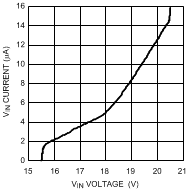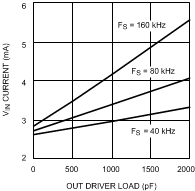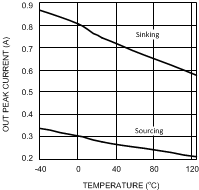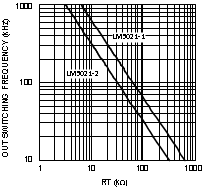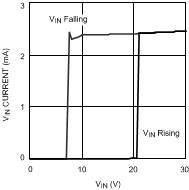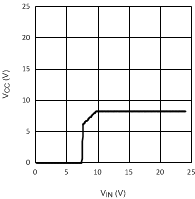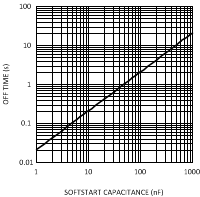ZHCSDU4E May 2005 – December 2014 LM5021
PRODUCTION DATA.
- 1 特性
- 2 应用
- 3 说明
- 4 修订历史记录
- 5 Pin Configuration and Functions
- 6 Specifications
- 7 Detailed Description
- 8 Application and Implementation
- 9 Power Supply Recommendations
- 10Layout
- 11器件和文档支持
- 12机械、封装和可订购信息
封装选项
机械数据 (封装 | 引脚)
散热焊盘机械数据 (封装 | 引脚)
- DGK|8
订购信息
6 Specifications
6.1 Absolute Maximum Ratings (1)(1)
| MIN | MAX | UNIT | |
|---|---|---|---|
| VIN to GND | –0.3 | 30 | V |
| VIN Clamp Continuous Current | 5 | mA | |
| CS to GND | –0.3 | 1.25 | V |
| RT to GND | –0.3 | 5.5 | V |
| All other pins to GND | –0.3 | 7.0 | V |
| Operating Junction Temperature | 150 | ||
| Storage temperature range, Tstg | –65 | 150 | °C |
(1) If Military/Aerospace specified devices are required, please contact the Texas Instruments Sales Office/ Distributors for availability and specifications.
6.2 ESD Ratings
| VALUE | UNIT | |||
|---|---|---|---|---|
| V(ESD) | Electrostatic discharge | Human-body model (HBM), per ANSI/ESDA/JEDEC JS-001(1) | ±2000 | V |
(1) JEDEC document JEP155 states that 500-V HBM allows safe manufacturing with a standard ESD control process.
6.3 Recommended Operation Conditions
over operating free-air temperature range (unless otherwise noted)| MIN | MAX | UNIT | |
|---|---|---|---|
| VIN Voltage (4) | 8 | 30 | V |
| Junction Temperature | –40 | 125 | °C |
6.4 Thermal Information
| THERMAL METRIC(1) | LM5021 | UNIT | ||
|---|---|---|---|---|
| DGK | P | |||
| 8 PINS | ||||
| RθJA | Junction-to-ambient thermal resistance | 163.3 | 53.5 | °C/W |
| RθJC(top) | Junction-to-case (top) thermal resistance | 56.7 | 42.9 | |
| RθJB | Junction-to-board thermal resistance | 83.2 | 30.6 | |
| ψJT | Junction-to-top characterization parameter | 5.9 | 20.1 | |
| ψJB | Junction-to-board characterization parameter | 81.9 | 30.5 | |
(1) For more information about traditional and new thermal metrics, see the IC Package Thermal Metrics application report, SPRA953.
6.5 Electrical Characteristics
MIN and MAX limits apply –40°C ≤ TJ ≤ 125°C. Unless otherwise specified: TJ= +25°C, VIN = 15 V, RT = 44.2 kΩ.(2)| PARAMETER | TEST CONDITIONS | MIN | TYP | MAX | UNIT | |
|---|---|---|---|---|---|---|
| STARTUP CIRCUIT | ||||||
| IST | Start up current | Before VCC Enable | 18 | 25 | µA | |
| VVIN_EN | VCC Regulator enable threshold | 17 | 20 | 23 | V | |
| VVIN_DIS | VCC Regulator disable threshold | 7.25 | V | |||
| VVIN_CMP | VIN ESD clamp voltage | I = 5 mA | 30 | 36 | 40 | V |
| IVIN | Operating supply current | COMP = 0 VDC | 2.5 | 3.75 | mA | |
| VCC SUPPLY | ||||||
| VVCC_EN | Controller enable threshold | 6.5 | 7 | 7.5 | V | |
| VVCC_DIS | Controller disable threshold | 5.3 | 5.8 | 6.3 | V | |
| VVCC | VCC regulated output | No External Load | 8 | 8.5 | 9 | V |
| VVCC_DO | VCC dropout voltage (VIN - VCC) | I = 5 mA | 1.7 | V | ||
| IVCC_LIM | VCC regulator current limit | VCC = 7.5 V (3) | 15 | 22 | mA | |
| SKIP CYCLE MODE COMPARATOR | ||||||
| VSKP | Skip cycle mode enable threshold | ⅓ [COMP - 1.25 V] | 75 | 125 | 175 | mV |
| VSKP_HYS | Skip cycle mode hysteresis | 5 | mV | |||
| CURRENT LIMIT | ||||||
| tCS_DLY | CS limit to OUT delay | CS stepped from 0 to 0.6 V, time to OUT transition low, Cload = 0 |
35 | ns | ||
| VCS_MAX | CS limit threshold | 0.45 | 0.5 | 0.55 | V | |
| tLEB | Leading edge blanking time | 90 | ns | |||
| RCS_BNK | CS blanking sinking impedance | 35 | 55 | Ω | ||
| SOFT-START | ||||||
| VSS_OCV | SS pin open-circuit voltage | 4.3 | 5.2 | 6.1 | V | |
| ISS | Soft-start current source | 15 | 22 | 30 | µA | |
| VSS_OFF | Soft-start to COMP offset | 0.35 | 0.55 | 0.75 | V | |
| RCOMP | COMP sinking impedance | During SS ramp | 60 | Ω | ||
| OSCILLATOR | ||||||
| FOSC | Frequency1 (RT = 44.2K) | 135 | 150 | 165 | kHz | |
| FOSC | Frequency2 (RT = 13.3K) | 440 | 500 | 560 | kHz | |
| VSYNC | Sync threshold | 2.4 | 3.2 | 3.8 | V | |
| PWM COMPARATOR | ||||||
| tPWM_DLY | COMP to OUT delay | COMP set to 2 V CS stepped 0 to 0.4 V, time to OUT transition low, Cload = 0 |
20 | ns | ||
| DMIN | Min duty cycle | COMP = 0 V | 0% | |||
| DMAX | Max duty cycle (-1 Device) | 75% | 80% | 85% | ||
| DMAX | Max duty cycle (-2 Device) | 50% | ||||
| KPWM | COMP to PWM comparator gain | 0.33 | ||||
| VCOMP_OC | COMP open circuit voltage | 4.2 | 5.1 | 6 | V | |
| VCOMP_MAXD | COMP at max duty cycle | 2.75 | V | |||
| ICOMP | COMP short circuit current | COMP = 0 V | 0.6 | 1.1 | 1.5 | mA |
| SLOPE COMPENSATION | ||||||
| VSLP | Slope comp amplitude (LM5021-1 only) |
CS pin to PWM Comparator offset at maximum duty cycle | 70 | 90 | 110 | mV |
| OUTPUT SECTION | ||||||
| VOUTH | OUT high saturation | IOUT = 50 mA, VCC - OUT |
0.6 | 1.1 | V | |
| VOUTL | OUT low saturation | IOUT = 100 mA | 0.3 | 1 | V | |
| IO_SRC | Peak source current | OUT = VCC/2 | 0.3 | A | ||
| IO_SNK | Peak sink current | OUT = VCC/2 | 0.7 | A | ||
| tr | Rise time | Cload = 1nF | 25 | ns | ||
| tf | Fall time | Cload = 1nF | 10 | ns | ||
| HICCUP MODE | ||||||
| VOVLD | Over load detection threshold | COMP pin | VSS-OCV – 0.8 | VSS-OCV – 0.6 | VSS-OCV– 0.4 | V |
| VHIC | Hiccup mode threshold | SS pin | VSS-OCV – 0.8 | VSS-OCV – 0.6 | VSS-OCV– 0.4 | V |
| VRST | Hiccup mode Restart threshold | SS pin | 0.1 | 0.3 | 0.5 | V |
| IDTCS | Dead-time current source | 0.1 | 0.25 | 0.4 | µA | |
| IOVCS | Overload detection timer current source | 6 | 10 | 14 | µA | |
(1) Absolute Maximum Ratings are limits beyond which damage to the device may occur. Recommended Operation Conditions are conditions under which operation of the device is intended to be functional. For specifications and test conditions, see the Electrical Characteristics.
(2) Min and Max limits are 100% production tested at 25°C. Limits over the operating temperature range are specified through correlation using Statistical Quality Control (SQC) methods. Limits are used to calculate Average Outgoing Quality Level (AOQL).
(3) Device thermal limitations may limit usable range.
(4) After initial turn-on at VIN = 20 V.
6.6 Typical Performance Characteristics
Unless otherwise specified: TJ = 25°C.